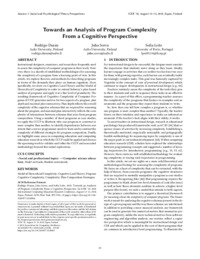Towards an Analysis of Program Complexity From a Cognitive Perspective Publikationsdatum:
Zu finden in: ICER 2018 (Seite 21 bis 30), 2018
|
 |
 Diese Seite wurde seit mehr als 7 Monaten inhaltlich nicht mehr aktualisiert.
Unter Umständen ist sie nicht mehr aktuell.
Diese Seite wurde seit mehr als 7 Monaten inhaltlich nicht mehr aktualisiert.
Unter Umständen ist sie nicht mehr aktuell.
 Zusammenfassungen
Zusammenfassungen
Instructional designers, examiners, and researchers frequently need to assess the complexity of computer programs in their work. However, there is a dearth of established methodologies for assessing the complexity of a program from a learning point of view. In this article, we explore theories and methods for describing programs in terms of the demands they place on human cognition. More specifically, we draw on Cognitive Load Theory and the Model of Hierarchical Complexity in order to extend Soloway's plan-based analysis of programs and apply it at a fine level of granularity. The resulting framework of Cognitive Complexity of Computer Programs~(CCCP) generates metrics for two aspects of a program: plan depth and maximal plan interactivity. Plan depth reflects the overall complexity of the cognitive schemas that are required for reasoning about the program, and maximal plan interactivity reflects the complexity of interactions between schemas that arise from program composition. Using a number of short programs as case studies, we apply the CCCP to illustrate why one program or construct is more complex than another, to identify dependencies between constructs that a novice programmer needs to learn and to contrast the complexity of different strategies for program composition. Finally, we highlight some areas in computing education and computing education research in which the CCCP could be applied and discuss the upcoming work to validate and refine the CCCP and associated methodology beyond this initial exploration.
 Dieses Konferenz-Paper erwähnt ...
Dieses Konferenz-Paper erwähnt ...
 Personen KB IB clear | T. Andrew Binkowski , B. S. Bloom , Duane Buck , Angela Carbone , Paul Denny , Brian Dorn , Francisco Enrique Vicente Castro , Kathi Fisler , Diana Franklin , David Ginat , Richard Gluga , Mark Guzdial , Jacob Hendrickx , Peter Hubwieser , Cruz Izu , Judy Kay , Simon Kleitman , Sabina Kleitman , Marja Kuittinen , Raymond Lister , Mike Lopez , Andrew Luxton-Reilly , Eti Menashe , Cheryl Moran , Briana B. Morrison , Andreas Mühling , Cheryl Pope , Kathryn M. Rich , Phil Robbins , Alexander Ruf , Jorma Sajaniemi , Judy Sheard , Beth Simon , Elliot Soloway , Carla Strickland , David J. Stucki , Amal Taya , Ewan D. Tempero , Errol Thompson , Amali Weerasinghe , Jacqueline L. Whalley | |||||||||||||||||||||||||||||||||||||||||||||||||||||||||||||||||||||||||||||||||||||||||||||||||||||||||||||||||||||||||||||||||||||||
 Begriffe KB IB clear | code smells
, cognitive load theory (CLT)
, Informatikcomputer science
, Informatik-Unterricht (Fachinformatik)Computer Science Education
, notional machine
,  Programmieren Programmieren programming
, rainfall problem programming
, rainfall problem
| |||||||||||||||||||||||||||||||||||||||||||||||||||||||||||||||||||||||||||||||||||||||||||||||||||||||||||||||||||||||||||||||||||||||
 Bücher |
| |||||||||||||||||||||||||||||||||||||||||||||||||||||||||||||||||||||||||||||||||||||||||||||||||||||||||||||||||||||||||||||||||||||||
 Texte |
|
 Dieses Konferenz-Paper erwähnt vermutlich nicht ...
Dieses Konferenz-Paper erwähnt vermutlich nicht ... 
 Nicht erwähnte Begriffe | Informatik-Didaktik, Informatikunterricht in der Schule |
 Tagcloud
Tagcloud
 Zitationsgraph
Zitationsgraph
 Zeitleiste
Zeitleiste
 2 Erwähnungen
2 Erwähnungen 
- ICER 2020 - International Computing Education Research Conference, Virtual Event, New Zealand, August 10-12, 2020 (Anthony V. Robins, Adon Moskal, Amy J. Ko, Renée McCauley) (2020)
- Programming Versus Natural Language - On the Effect of Context on Typing in CS1 (John Edwards, Juho Leinonen 0001, Chetan Birthare, Albina Zavgorodniaia, Arto Hellas) (2020)


- Programming Versus Natural Language - On the Effect of Context on Typing in CS1 (John Edwards, Juho Leinonen 0001, Chetan Birthare, Albina Zavgorodniaia, Arto Hellas) (2020)
- WIPSCE '23 - The 18th WiPSCE Conference on Primary and Secondary Computing Education Research (Sue Sentance, Mareen Grillenberger) (2023)
- Applying the Mathematics Task Framework to K-8 computing (Michael Deutsch 0003) (2023)


- Applying the Mathematics Task Framework to K-8 computing (Michael Deutsch 0003) (2023)
 Anderswo finden
Anderswo finden
 Volltext dieses Dokuments
Volltext dieses Dokuments
 |  Towards an Analysis of Program Complexity From a Cognitive Perspective: Fulltext at the ACM Digital Library ( Towards an Analysis of Program Complexity From a Cognitive Perspective: Fulltext at the ACM Digital Library ( : :  , 1141 kByte; , 1141 kByte;  : :  2020-11-28) 2020-11-28) |
 Anderswo suchen
Anderswo suchen 
 Beat und dieses Konferenz-Paper
Beat und dieses Konferenz-Paper
Beat hat Dieses Konferenz-Paper während seiner Zeit am Institut für Medien und Schule (IMS) ins Biblionetz aufgenommen. Beat besitzt kein physisches, aber ein digitales Exemplar. Eine digitale Version ist auf dem Internet verfügbar (s.o.). Es gibt bisher nur wenige Objekte im Biblionetz, die dieses Werk zitieren.





















 Biblionetz-History
Biblionetz-History